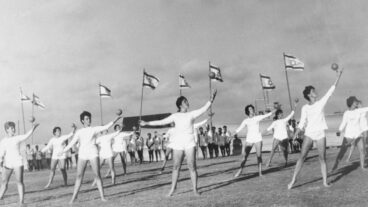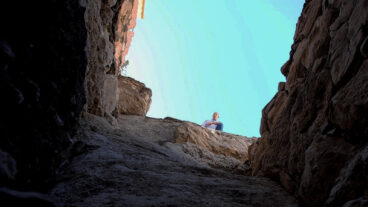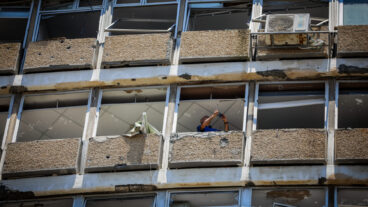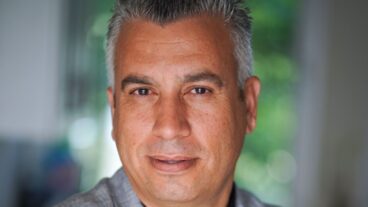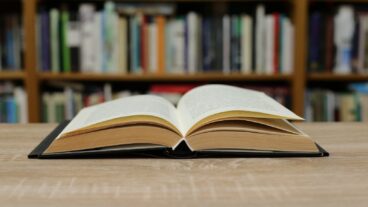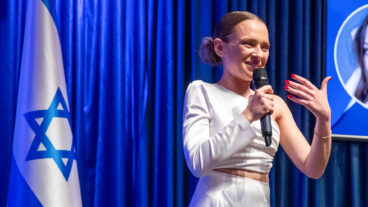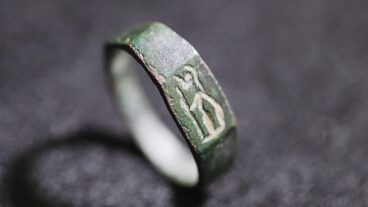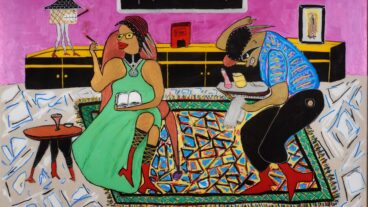Two 12-year-old participants, Zvi and Raneen, share a brief, friendly moment of mutual interest with Jason Eskenazi.Four years ago, New York photographer Jason Eskenazi made his first trip to Israel. His unusual travel belongings consisted of two dozen Cannon cameras, 250 rolls of blank film and a flier, translated into Arabic, announcing a photography class he intended to teach to Jewish and Arab kids.
Eskenazi, a Fulbright scholar and recipient of numerous prestigious photography awards, spoke no Hebrew or Arabic. In 2004, he was awarded a small grant from Kids with Cameras, a non-profit educational group started by Zana Briski, the Academy Award winning photographer and director of Born Into Brothels.
Six months later, in 2005, through trial and error, mishaps, persistence and a touch of serendipity, Eskenazi learned the transformative power of art, turning 12 Jewish and 12 Arab Jerusalem kids between the ages of eight and 12-years-old, into keen-eyed photographers who chronicled their lives and the world they inhabit.
Along with the pictures, they developed a rapport. He earned their trust and sparked their curiosity in learning about each other, as well.
An exhibit of their stunning photographs, Kids with Cameras: Beyond the Wall, has traveled to major US cities, including New York, San Francisco and Austin, Texas, and is currently on view through July 31 at the Boston Public Library, cosponsored by Zionist House/Israel Cultural Center and the Consulate General of Israel to New England.
Empowering the kids
“My goal was to empower [the kids] to see the world they live in,” Eskenazi said at the opening reception of the exhibit, in honor of Jerusalem Day.
“There was no hidden agenda, no political motivation,” Eskenazi asserted. “The cameras gave voice to the kids.”
While the photographs have been previously displayed in Jewish Community Centers, Zionist House intentionally mounted this exhibit in a very public space, opening the program to a wider audience, explains Avis G. Jacobson, chair of the Jerusalem Day event.
The whole idea is to present positive images of Israel, she emphasizes, offering audiences a chance to see something they’re not expecting.
Jacobson says the kids brought a youthful perspective to familiar Old City images. “I came away with something fresh and different,” she said.
Standing in front of one of the photographs, Pensive Girl Looks at City, by 11-year-old Tchiya, Eskenazi says that he particularly likes the more personal photos shot by the kids. In the photo, a girl leans on her arm, gazing out over the Old City at twilight.
“It’s sort of mystical and magical. You can go into the head of the person pictured. The empathy of that, to be able to do that, is very powerful. That’s what I look for when I take photos,” he commented.
The Arab children, who held their classes at the Old City’s Martin Luther Center, shot their photographs in churches, in the Jewish quarter, along the security barrier, in their houses, the marketplace and included images of family, friends and strangers. The Jewish kids, recruited through the Moross Community Center, shot photographs by the Western Wall, on their way to school, of family and on some of their own school excursions.
When the kids accidentally discovered that he was teaching the other group, Eskenazi used the opportunity to share each group’s individual photo albums with the other. At first, some of the kids in both groups made hissing sounds and even spat, Eskenazi recalls. But eventually, their curiosity to see each other’s photographs and glimpse their lives trumped the initial schoolyard antics.
“They learned about each other through viewing their photographs,” Eskenazi said.
Eskenazi brought the two best Jewish and Arab students together to meet and look at each other’s photos. The scene of Zvi and Raneen, both 12, sitting on either side of Eskenazi, sharing a brief, friendly moment of mutual interest is captured in a photo also on display at the Boston Public Library show.
By using cameras, the kids were able to find their own voices and learn how to see others, says Nadav Tamir, Israel’s consul general to Israel for New England. “It’s a great lesson on how people can have different perspectives and different narratives and have empathy for the other.
“It’s a good way for all of us in Jerusalem to learn how to live together,” he said in a conversation at the exhibit.
Following the show in Austin, the Jewish Community Center there was inspired to begin its own version of Kids with Cameras to break down barriers between different groups in that city. This gives the project new meaning, Eskenazi says.
His main hope is to return to Jerusalem to mount an exhibit there, to bring the kids and their families together and to expand the program throughout Israel. Zionist House’s Jacobson agrees it would be beneficial to bring the kids together.
When he began this project, Eskenazi says he did not believe that art and photography had the power to change kids’ lives. Through the process, Eskenazi says he learned the only way to make a difference in big policies is to produce change organically, through individuals.
“I’m into the Jewish proverb,” admits the completely secular Jew. “If you save one life, you save the world.”
Reprinted courtesy of The Jerusalem Post.




